When people find out that I deal with swimming pools on a daily basis, one of the most common questions I get is, “What do you think about salt pools?” to which I find myself going into a little sales blurb on what a salt pool is. I would say 90% of the people have heard of salt pools, but don’t really know how they work. Most know they are supposed to be nicer than chlorine pools and think that salt pools don’t use chlorine, but this is not the case. This article will explain how a pool salt system works, if one is the right choice for you and then the process of converting your pool from traditional chlorine to salt.
What is a salt water pool?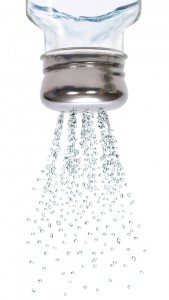
With a salt pool, you add salt to your pool water. This amount is below the taste threshold meaning you don’t taste a strong salt taste like associated with the ocean. Ocean water is at 50,000 parts per million (PPM) of salt. A salt pool is a mere fraction of this and only has 3,000 PPM of salt. In a salt pool an electrode (also called a salt cell) is installed in your plumbing and as the diluted salt water passes through the cell, the electrical reaction between the electrode and the salt water creates chlorine. So, with a salt pool you are still using chlorine to sanitize your pool as you are just manufacturing your own. The chlorine that is produced by a salt pool is a higher quality of chlorine that does not have the negative effects of traditional chlorine like the chlorine smell, red eyes and itchy skin. With a salt pool you no longer need to purchase chlorine tablets, liquid chlorine or shock as the salt system will be creating all of your chlorine. Salt systems also have a superchlorination feature that acts as shocking your pool. If you’re interested in learning more about salt water pools then I would suggest reading our recent blog post on “What is a Salt Water Pool” which goes into much greater detail on this topic.
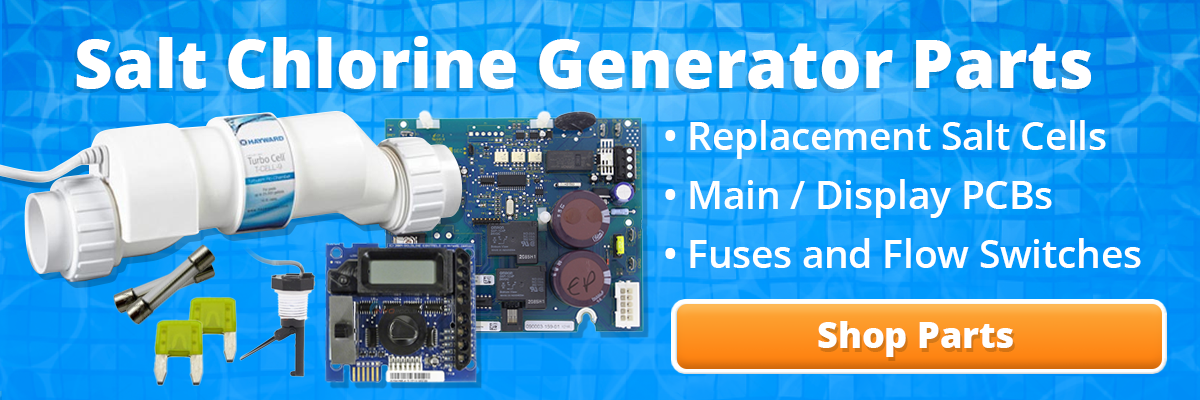
The pros & cons of salt pools
Pros:
- No more buying chlorine – A salt system manufactures natural chlorine. That means no more buying chlorine tablets, shock or liquid chlorine!
- No more manually adding chlorine – On a salt system you dial in your chlorine production and that is it. This is a major benefit over traditional chlorine where you have to make sure to add your chlorine to the pool each week and if you forget or go on vacation then you are faced with issues. I have to admit this is my favorite benefit of a salt pool.
- No chlorine smell, red eyes or itchy skin – The negative effects of chlorine like the chlorine smell, red eyes and itchy skin are all due to chloramines. The chlorine that is produced by a salt pool does not have chloramines. This means all of these traditional side effects of chlorine are eliminated. This is the reason why many people who swim in a salt pool think that it is a non-chlorine pool.
Cons:
- High pH & calcium build-up – In salt pools the pH level of the water likes to rise. If you don’t keep your pH levels in check then this can lead to calcium scaling in your pool or your salt cell. This is easily maintained by testing your pH levels weekly and adding muriatic acid if you need to lower your pH.
- Salt cell replacement – Every 3-7 years you will need to replace your salt cell which costs between $200 – $700.
- More parts – On a salt system there are more parts which can become faulty like the circuit board, salt cell, flow sensor or flow switch.
- Corrosive to pool and equipment? – This topic is open for debate as many pool professionals feel salt water is perfectly fine for your equipment and others feel you need special equipment. Our experience is that sometimes the shaft seal on your pool pump may fail a little quicker, but this is an easy inexpensive fix. If you are adding a heater to your pool you may consider a cupro nickel heater as this heater has a heavy duty heat exchanger which is supposed to hold up better to salt. The last item you may consider is a sacrificial zinc anode. You place this zinc disk in your skimmer and the anode absorbs all the corrosion
Converting from chlorine to salt
Once you have made the decision that you want to convert from a traditional chlorine pool to a salt pool then your first decision will be which salt system to choose. A few considerations you will want to take into account when selecting your salt system are listed below.
Selecting your salt system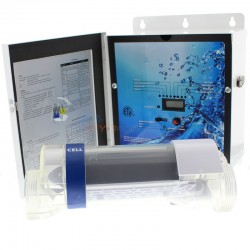
- Pool size: Salt systems range from pools 10,000 gallons – 100,000 gallons. You will need to select the system based on your pool size. You can always go with a larger unit on a smaller pool. This will allow you to run the salt system for shorter periods of time and you will have longer time between replacing your salt cell.
- Budget: Salt Systems can cost anything from $500 – $2,000. The less expensive models have few bells and whistles where the higher end systems have a bunch of fancy features including the ability to control all your pool equipment.
- Features: Salt systems vary in regards to the features offered. Some of these features include: salt readout, self cleaning, self diagnostics, digital readout and the ability to control pool equipment.
- Replacement cell cost: This is an important factor and is often overlooked. Your salt cell will need to be replaced every 3-5 years. Replacement salt cells range from $200 – $700. So, if you get a salt system which uses a $200 cell then you could replace this cell 3½ times before it costs as much as replacing the $700 cell.
- Where to buy: Here you can check out our full line Salt Chlorine Generators we even have a model for in-ground pools starting at $499.

Installation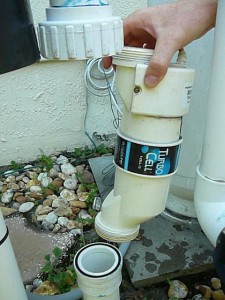
Now it is time to decide if you are going to hire a pool company to install the salt system or do it yourself. If you go the pool company route, then you are looking at $300 – $500 for installation. Many homeowners decide to tackle this DIY project themselves as this is usually a 3-6 hour job that can be tackled over the weekend. We have put together a step-by-step video on “How to Install a Salt Chlorine Generator” which would be a good primer to see if you think you can tackle the job. The installation consists of some basic plumbing and electrical work.
Adding the salt
After you have installed your salt system the next step is to add the salt to your pool. We have put together a guide on “How to Add Salt to a Pool“ which discusses this process in greater detail, but we will touch on the basics which are:
- How much salt do you need?
- Testing water
- Selecting salt
- Adding salt
The first thing you will want to do is check the owner’s manual to determine how much salt you will need. Normally this will be between 400 lbs. – 1,000 lbs. based on the size of your pool. You will want to pick up some pool salt test strips as you don’t want to assume that you are starting at 0 PPM of salt as often your water will have some salt in it (for example you may be starting off at 200 PPM of salt). The salt strip will also be used after you add all of your salt to ensure you are within the 3,000 – 3,5000 PPM salt range.
Next you will need to pick up some pool salt. This can be easily found at your local home improvement store, pool store or even grocery store. You will just want to make sure the salt you choose is at least 99.8% NaCl and that it is granular (no pellets or rock salt). Often people get concerned when they hear that they need to add 400 lbs. of salt, but this is just 10 bags of salt (40 lb. bags) and salt costs about $5 per bag so this would be about $50 in salt. Salt does not dissolve from water meaning that you will only need to add additional salt if you experience evaporation, heavy rain, water being splashed out of the pool or a leak. Normally you would add several bags of salt throughout the year to maintain the required salt levels.
Now it is time to add the salt to your pool. Your pool pump should be turned on and the salt system should be turned off. You will want to broadcast the salt evenly around the pool for even distribution. Avoid adding the salt directly to the skimmer or main drains at the bottom of the pool as this can damage your equipment. You will run your filter pump for 24 hours to allow for the salt to mix evenly through your pool water. After 24 hours use your salt test strip to verify that you have the correct salt reading of 3,000 – 3,500 PPM of salt.
Starting up the salt chlorine generator
It is very important to start off with good pool water. Your water chemistry should start off at the following values:
Salt: 3,000 – 3,500 PPM
Free Chlorine: 1.0 – 3.0 PPM
pH: 7.2 – 7.8
Cyanuric Acid (Stabilizer): 50 – 75 PPM
Total Alkalinity: 80 – 120 PPM
Calcium Hardness: 150 – 400 PPM
At start up it is best to shock your pool from an outside source like a standard granular pool shock. Then, wait until the chlorine level has returned to between 1 to 3 PPM before turning on the salt system. Now it’s time to kick on your salt system. We suggest setting the system to 50% chlorine production and let the system run for 24 hours. After 24 hours test your pool water with a good test strip to see if your free chlorine is between 1-3 PPM. If your chlorine is too high or too low, dial your chlorine product up or down in 10% increments and retest your chlorine in 24 hours. Repeat this process until the proper chlorine level is reached. The nice thing is that once the salt system is dialed in it is pretty much a set-it-and-forget system, because it is always there producing natural chlorine for your pool at the desired amount to keep your pool crystal clear. Salt systems also have a superchlorinate feature which shocks your pool. So if you ever run into demanding water conditions then this feature comes in handy to shock your pool and get your pool water looking clear again.

Maintenance
Testing your water
Now that you have your salt system up and running you will want to periodically test your water to make sure that your water chemistry is in balance with the values listed earlier in this article.
Prolonging the life of your salt cell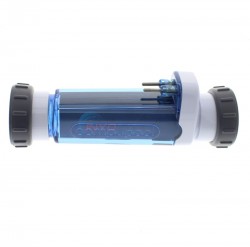
Salt cells normally last 3-7 years. To get longer life out of your cell, you will want to follow certain steps.
As your salt cell is in use, calcium deposits will build up on the blades of your salt cell. To remove this calcium build up, soak your cell in diluted acid solution. To prolong the life of your cell, you will want to clean it at least once a season. On the flip side you want to make sure you do not clean your cell too often or with too highly concentrated acid solution as this can strip the cell of its titanium coating making it useless.
Calcium build-up
Salt pools tend to make the pH in your pool want to rise so it is important that you are monitoring your pH levels and adding muriatic acid to reduce the pH. High pH levels cause much quicker calcium build up on your salt cell as well as on your pool tiles. I learned this the hard way! If you want to get fancy, many pool owners are coupling their salt systems with an acid feed pump. This is nice as the production of chlorine in your pool is automatically produced by the salt chlorine generator and the pH levels are automated by the feed of acid from the acid pump.
Need help converting your pool to saltwater?
When I built my pool I installed a salt system and I can honestly say it is one of my favorite features of my pool. After the initial set up, I really did not had to worry about my chlorine at all. If you have decided that you want to convert your pool from traditional chlorine to salt then post any questions in the comments below and we would be happy to help. Also if you have already made the switch, we would love to hear about your experience. You can also always reach us by phone at 1-877-372-6038 with any questions.

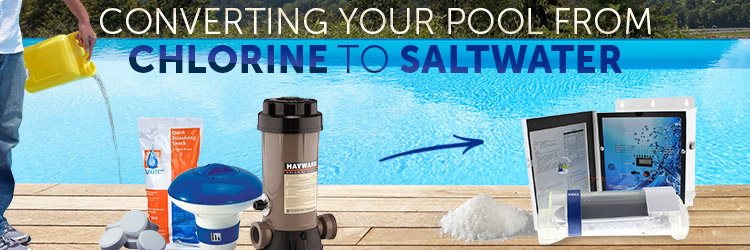

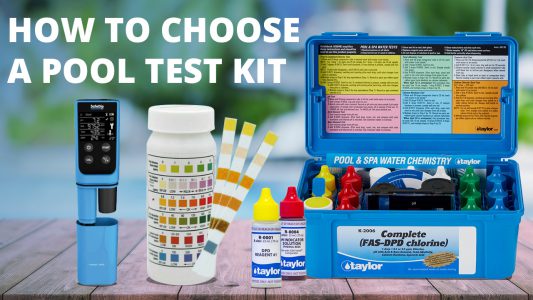
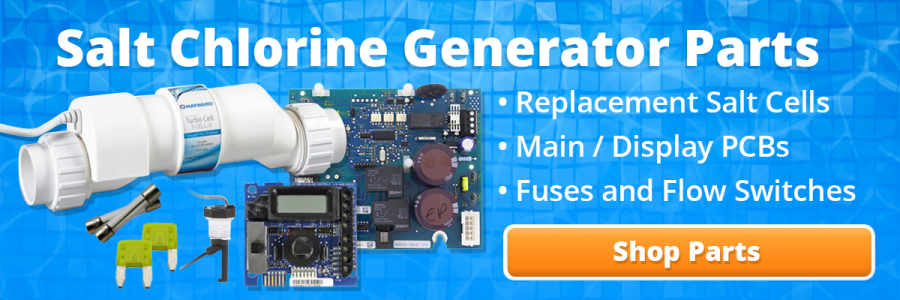
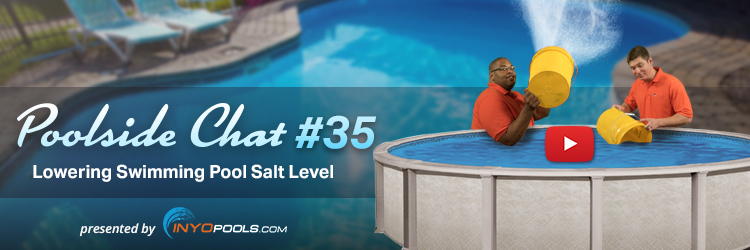
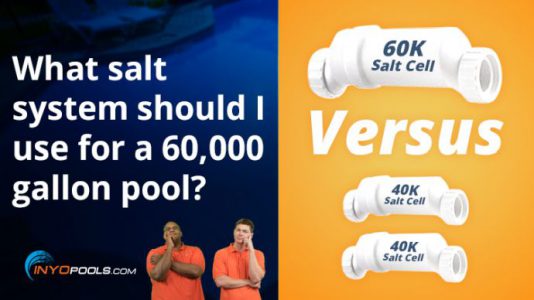






I just installed an 20×48 Intex above ground pool. I invested in a saltwater pump and filter. I have tried leveling the ground, including replacing the sod with sand. I am still 1 1/4 inch off level. How much will this affect the efficiency of the filter?
I fought mustard algae all last year. Will salt systems get mustard algae?
The salt chlorine generator should produce enough chlorine to prevent any algae from taking hold. You will still need to make sure the rest of the pool water chemistry is up to snuff. The reason you had mustard algae before was due to chemical imbalance.
So what other chemicals are needed for prevention of mustard algae with a salt system. It is an 18,500 gallon above ground. I used to use Pristine Blue and never had issues but the chlorine was hard for me. I love the idea of salt, but a lot of confusion I guess as to what is the easiest to maintain.
If the water is properly balanced, algae can’t grow. Chlorine is a caustic material, that is why humans shouldn’t touch undiluted chlorine, and definitely shouldn’t breathe it in. If the chlorine level is 2-3 ppm, algae will not grow regardless of the presence of algaecide. Whether the chlorine is sourced from a tablet or created by the salt cell, if the chlorine is at the right levels, bad stuff like algae, bacteria, and other nasties will not get a foothold.
The salt is easiest to maintain once everything is set up. If your above ground pool is all steel, salt is not a good option for you. Salt + Steel = Rust
Have a look at this guide: How To Maintain A Swimming Pool Part 1 (Chemicals)
I have a 35,000 gallon pool, but have copper plumbing. Can I still convert to salt?
I wouldn’t suggest it. Pool heaters with copper heat exchangers get eaten away by salt.
I have a 27 foot above ground that I have thought of converting. However, I have been struggling with how much maintenance is there really involved with it? Last year, I had nothing but trouble with the chlorinated pool system and fought mustard algae the whole season so hardly got to get in the pool all summer. Will a salt system keep you from getting mustard algae? It seemed like the chlorine was way harder to obtain than when we previously maintained it with pristine blue and I know nothing about salt systems but have been interested.
Perfectly written content , thanks for information .
I have a 150000 gal above ground pool. Sand filter has a flow of 4800. Which salt generator is best for my set up? Thank you
As Patrick mentions in the article when sizing the system, you mainly have to take into consideration the pool size in gallons. Salt systems are rated by gallons. I’ll presume you meant type 15,000 gallons; this would mean a salt system meant to chlorinate pools up to 20,000 gallons would be a perfect fit.
Matthew, I have a SGSBreeze 320 that was installed by the pool builder and based on my 14×33@average 5 foot plus 8x8x4 deep spa (same pump and system) I think I’m around 19000Gal. My electrode seems to have died, (4 years old and no chlorine seems to be getting generated.) Do you know if I can buy the electrode for the 40k Gal unit and just insert it into the Breeze320 or do I have to replace the entire system. Or… Should I just replace the little 3 plate one and cry over my pool guy barely putting in the right capacity system?
can a cement pool be converted to salt?
Yes, a gunite pool can be converted to saltwater.
Hey Matthew – great blog! We have a 18 X 36, 55,000 gallon pool and looking to convert from chlorine to salt. Many of the salt units appear to be rated for 40,000 gallons. I’ve also read about the importance of not buying a system that would be running at its maximum capacity to fulfill minimum requirements of the pool. 2 questions then;
1) Is there a particular system you would recommend for this size of pool? Our filter and variable speed pump are haywards.
2) I have read about the benefits of using two parallel salt systems (say two 30,000 or 40,000 gallon systems) vs. buying a single large salt system. Any insights into that approach?
First, I think you have miscalculated your gallonage; unless your pool has a constant depth of 12-feet, an 18′ x 36′ is not going to hold anywhere near that amount. A pool that size would top out at about 30k Gallons.
1) With that said, you can use a CrystalPure 40k or an Intellichlor IC40
2) You will not need to stack cells with the corrected gallonage. If you really wanted to oversize the system, you can go with the IC60 or the CrystalPure 60k
I have a Intex pool 18×48 6423gals. Will my salt water system for pools up to 7000 gals produce enough chlorine for this size pool or should I go to a larger one.
Yes, it will produce enough chlorine but you will need to run it close to its full capacity to keep up with chlorine production
We have a 18ftx9ftx48 in Bestway above ground pool heavy duty PVC and polyester 3 ply side walls. Can we use a saltwater filter with this pool and what would you recommend.
I am not familiar with Bestway pool models but the manual should say if it can be filled with saltwater.
A common concern is whether the area around your pool will be damaged by converting to salt water. Probably no more than it would be affected by chlorine. Metal pool furniture and fixtures may suffer corrosion over time, so it s best to avoid those materials, if possible.
Sorry if this has already been answered (I didn’t have time to scroll through all of the posts), but can you convert to salt with a vinyl liner? If so, do you get more life out of a liner using salt vs. a traditional chlorine system? Thanks!
Hello Matthew,
I have a residential in ground pool (abo 10K gallons) and want to convert it to saltwater and also a solar pool pump like Lorentz paired with solar panels to offset utility usage. Do you recommend I either buy the specific solar pool pump or just invest in a decent inverter system to power the existing A.C. pool pump. setup? TIA
Good question. My short answer would have to be: ¯\_(ツ)_/¯
But seriously, I am not too familiar with that genre of pool equipment, making a compare and contrast difficult. You may want to try posting this question over at the pool forum (www.TrobleFreePools.com). There are a few people that can help you with this solar pool pump question.
Hello, good article. We have a 27′ round above ground and we are constantly fighting with algae. Right now my pool is the same color as my lawn. Considering converting to salt. Do I still use my sand filter? Do I need to add shock on a regular basis?
Matthew,
Great article and blog. Hopefully I’m not repeating a question. I have a 25,000 gallon inground pool with a vinyl liner. For the conversion to salt system, does the chlorine generator work on the timer I have my pump on? I run the pump 11 hours per day. How often do you have to add acid; for example, I can go away for close to 2 weeks now without worrying about anything because the chlorine tabs in my CL200 will last that long, and pH is very stable. I want to be sure not to salt up my solar panels. Thank you.
The salt system should be linked to your pump’s schedule so that it is not activated when there is no water flow. The flow switch for salt systems is meant to prevent the salt system from causing itself harm if there is low water flow, but that part can be rather flimsy. I wouldn’t want to rely on that flows witch alone to protect the system
Once the CYA is in the pool, it doesn’t leave the pool unless you drain the water. So, unless you have an overzealous pool boy who really likes long backwashes while you are on vacation, you should be fine.
Matthew – I too have an Intex pool this year which came with it’s own pump, hose and attachments. Wanting to convert over to salt water, I now purchased a saltwater system with ECO off Amazon in hopes that is all I would need (other than the salt). It appears too easy to be true that this is all I would need. I live in a rural community and the closest pool store is 100 miles away. Any help would be appreciative!
Honestly, follow the directions that came with the box or read the second half of the article and it covers the basics of installing the chlorinator. As Patrick covers above, it is a relatively easy depending on how handy you are.
Eco is not a brand Inyo Pools carries, so I do not have much experience with it. But I know they are supposed to be simple to operate.
Hello. We have an 18×36 chlorine in-ground pool in upstate NY. We would like to convert to salt when opening this season. However, we always have algae/chemical balance issues which take a few days and a lot of chemicals to clear up. Will we still have to go through this process and then convert to salt or might there be a different way to handle things. Thank you in advance!
I would convert to salt after de-greening the pool. I’m sure the saltwater chlorinator could handle it, but I owuld let it start with a clean slate. Plus, if you have to do a lot of backwashing, you are wasting a lot of salt; of which, you will need to add to compensate for freshwater.
Look at it this way, if you just got a new truck would take it muddin’ right away? Nah, I would break it in first. There is no reason to test the limits of the unit right out of the box.
Hi,
I’ve had a Pentair in line salinator since last year which was working fine. Have had a heck of a time getting my pool opened this year. I’m pretty disabled and rely on my pool guys, but my brain still works pretty well. It was constantly white and cloudy and for weeks I asked them to check the screens in my ancient Hayward pump. Though it came with my house…25? Years ago, I know that holes in screens leak DE. Anyway, had replaced screen enough times and the manifold was also decrepit so I have a new Pentair filter.
My Pentair filter is working fine. I do not have a good test kit. Just some “strips” I used in a little spa. It says low chlorine. ph ok. The inline salinator only says “low salt”. It says ideal is 3600 ppm. I’m presuming there is no way to find out the salt level without testing the water, is that right? It just became low so I was wondering if I could gradually add 10 lb bags, let it dissolve and then run the syste, or should I wait for someone to test the water for me (and buy my own kit)
As expensive as the inline salt thingamajiggy was that generates the chlorine, I’d think it would have a saline readout! As the water passes through. Lots of other zingy green lights like “flow” and what level you want to run it at. If salt is low (but I don’t know how low!). Would there be any point in running it at a higher percentage.
Low could equal zero, since the strip shows zilch, zero, no color change. I know those aren’t accurate, but I’d think they are ballpark.
I don’t want to over-add salt. What do you think? It’s VERY hot here in Virginia. I also don’t have any shock. I guess I can see what can be delivered.
Hello Monk – the only way to test your water accurately is to get a free test at a local water store or get a good saltwater test kit. Remember, measure twice and cut once, so always know what you need before you start adding stuff to your water.
The test strips you have now could be fouled in some way. Or because you have a DE filter, backwashing could have lowered your salt levels. But the first move is to test your water.
Hi,
Thank you for the very informative article. We are purchasing a house with a chlorine pool in a few weeks and want to convert it to salt water. What equipment do you have to buy for the conversion? Do you recommend getting a pool company to adjust the chemical balance in the chlorine pool before you start the conversion? Also, how is a salt water pool managed? How often do you check the balance in the pool or is this something just for chlorine pools. My husband and I have no clue, we just moved to AZ and are total amateurs. We do want to have a salt water pool. Any advice for two amateurs and how to approach this?
Thank you
//Sasa
It’s weird that you thanked them for the informative article, but obviously didn’t read it. All your questions are answered in the thing, for cripes sake.
#burn love the article though lol
Sorry if this was already covered. Do you have to drain the chlorine water when converting to salt? Also we have dolphin robotic premier cleaner, do we need a salt water specific cleaner?
Whoops I see part of the answer in the previous post. Lol sorry.
No and no. Pool cleaners wouldn’t be affected by the salt.
Can you convert a pool to a salt water at any time? If I’m opening my pool with traditional chlorine can I switch to salt after I let those chemicals dissipate? Or is it better to install a salt system at the beginning of a season?
Thanks!
You can convert your pool to saltwater at any time. The only restrictions that I know of, are with freshly resurfaced pools. For example, newly replastered pools should not be converted for 60-90 days.
Thanks.
What about repaint? We’re not replastering but will be repainting it.
Hello, I have already put chlorine in my pool can I switch it to salt ?
Yes, the presence of chlorine will not affect the salt generator.
Matthew,
We have a seasonal outdoor pool at the country club where I work. It has over 200,000 gallons of water. It’s an older pool with older equipment and only open summer seasonal. What is your best ballpark estimate of the cost to convert to salt? I get asked this all of the time. Any reply would be extremely helpful. Thanks!
Chris
My ballpark estimate on how much it would cost to convert to salt for you would simply say “a lot.” Commercial units themselves are pretty hefty but with you being on the high end you will either need link together several systems or get one that can have a multiple cell array. A system that has a multicell array is the AutoPilot Pool Pilot Professional. You would the six-cell system at least, here is the sizing guide. The AutoPilot would probably be your best bet.
As for the cost of sault, here is the AutoPilot’s salt chart, to show how many pounds you would need to add to reach the desired salinity level:

I have 5ft x 22ft above ground pool an i am swapping over to a salt wwter and i want to know the best size pump to use an wat else i nee dto set one up
You can keep the same pump, converting to salt would not affect your current pump. To be cautious, you can upgrade your pump’s shaft seal to the saltwater version. Also, if your above ground pool is all steel, I do not suggest making the conversion. Resin and some hybrid pools are the preferred types to use for salt installations.
As for what you would need to do to convert to salt, it is all covered in the article.